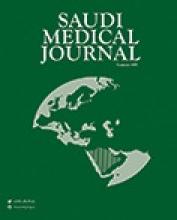Abstract
OBJECTIVE: The aim of the study is to compare the frequencies of complications among adolescents with type 1 diabetes (age 12-18 years) treated with either intensive insulin regimen (4 injections per day) or conventional regimen (2 injections per day).
METHODS: The study was carried out at the Childrens Hospital, Quebec, Canada during the period 1997 to 1999. This retrospective survey involves a chart study of type 1 diabetic children aged 12-18 years. The frequency of retinopathy, nephropathy (albuminuria), diabetic ketoacidosis (DKA) and hypoglycemia were determined among the children on 4 insulin injections per day and those on 2 injections per day. The 2 groups were matched for age, sex, body mass index, insulin dosages and glycosylated hemoglobin levels.
RESULTS: The frequencies of DKA (25% versus 30%) and hypoglycemia (25% versus 30%) were comparatively less among the intensive therapy group compared with the conventional therapy group. The incidence of retinopathy was approximately the same (8% versus 7%) in the 2 groups and nephropathy did not feature in any patient in the series.
CONCLUSION: Intensive insulin therapy appears safe and advantageous over conventional regimen in the age bracket 12-18 years as has already been proven for individuals above the age of 18 years and adults. It can be recommended for this age group to forestall the morbidity of childhood diabetes.
- Copyright: © Saudi Medical Journal
This is an open-access article distributed under the terms of the Creative Commons Attribution-Noncommercial-Share Alike 3.0 Unported, which permits unrestricted use, distribution, and reproduction in any medium, provided the original work is properly cited.






